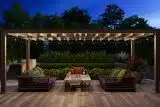The Art of Custom Interiors: Personalizing Your Home For Comfort And Style
General
Posted by: Tyler Miller 1 year ago
Customizing your home’s interior goes beyond selecting trendy colors or chic furniture; custom interiors are about creating a functional environment tailored to your unique lifestyle.
Whether you’re setting up a vibrant space for hosting friends or a peaceful area for your hobbies, each choice reflects your personal taste and everyday needs.
This blog will guide you through the key considerations in designing custom interiors, from selecting durable materials to optimizing your living space with intelligent lighting solutions.
Discover practical tips on how to ensure that every aspect of your home not only looks great but also enhances your way of life.
Ready to get started on customizing your home’s interior spaces? Click below to get in touch with Timber Rock Construction.
Understanding Tailored Living Spaces

Custom interiors involve more than selecting furniture and painting walls. It’s about creating environments within your home that are tailored to your lifestyle, aesthetics, and practical needs.
This process involves detailed planning, from the layout of rooms to the materials and finishes used, to the integration of technological enhancements.
The benefits include a home that:
- Reflects Personal Style: Custom interiors offer the freedom to express your personal style without the constraints of standard solutions. Whether you prefer minimalist, contemporary, or traditional designs, your living environment can be adapted to reflect any aesthetic.
- Enhances Comfort: By tailoring spaces to your needs, you can greatly enhance comfort. Ergonomically designed spaces, personalized lighting schemes, and tailor-made furniture can all contribute to a home that feels like a personal retreat.
- Optimizes Functionality: Personalized home design allows for the optimization of space according to your specific needs. From built-in storage solutions to multi-functional areas, your home can be designed to maximize efficiency and utility.
Starting with a Vision
The first step is to have a clear vision. Consider what elements are most important to you. Consider things like:
- Space for Entertaining: Do you envision hosting gatherings and need a layout that accommodates guests comfortably?
- Functional Home Office: With more people working from home, having a dedicated and functional office space is essential.
- Cozy Reading Nook: Perhaps you’re looking for a quiet, comfortable corner where you can unwind with a good book.
- Outdoor Connectivity: Are you looking to integrate indoor and outdoor living spaces for a seamless flow, perhaps through large sliding doors or an outdoor kitchen?
- Personal Wellness Area: Would you like to incorporate a home gym, spa, or meditation area to promote health and wellness within your living space?
- Child-Friendly Zones: If you have children, consider areas designed specifically for play and learning, which can be easily supervised.
- Artistic Displays: For art lovers, displaying collections beautifully and safely might be a priority.
Choosing the Right Materials
Materials play a crucial role in both the aesthetics and functionality of your home. For durability and style, choose materials that not only look good but are also suited to your lifestyle.
For instance, if you have pets or children, you might opt for stain-resistant fabrics and rugged flooring materials.
- Pets or Children: Opt for stain-resistant fabrics and rugged flooring materials that can withstand the wear and tear of daily life.
- High Humidity Areas: In places like bathrooms or kitchens, choose moisture-resistant materials such as ceramic tiles or treated wood to prevent mold and warping.
- Sunlit Spaces: If parts of your home receive a lot of sunlight, UV-resistant fabrics, and window treatments can help prevent fading and maintain the color and integrity of your interiors.
- Eco-Friendly Preferences: For those who prioritize sustainability, materials like bamboo flooring, recycled glass countertops, and low-VOC paints can enhance your home while aligning with your environmental values.
- Luxury Aesthetic: If luxury is a key aspect of your style, materials like natural stone, hardwood, or high-end metals can provide a sophisticated touch and lasting quality.
Lighting: Setting the Mood
Lighting is a powerful tool in interior design, capable of transforming the mood of a space instantly. Utilize a combination of ambient, task, and accent lighting to create environments that are adaptable and atmospheric.
Smart lighting systems can offer added flexibility, allowing you to adjust settings according to the time of day or the occasion. For example:
- Ambient Lighting: Use soft overhead lights to provide a baseline level of comfort and visibility, perfect for everyday living spaces.
- Task Lighting: Incorporate focused lighting in areas like kitchens and offices where specific tasks are performed to enhance functionality and reduce eye strain.
- Accent Lighting: Add smaller, decorative lights such as wall sconces or strip lights to highlight architectural features or artworks, adding depth and character to the room.
- Mood Lighting: Implement dimmable options and colored lights that can be adjusted to create different atmospheres, ideal for entertaining or relaxing.
- Natural Lighting: Harness sunlight with strategically placed mirrors and reflective surfaces to amplify natural light during the day, contributing to energy savings and a brighter home environment.
Combining these lighting strategies effectively can make each room in your home more versatile and enjoyable, enhancing both the utility and aesthetics of your spaces.
Space Planning and Layout
Effective space planning and layout are fundamental to creating a custom interior that not only looks beautiful but also functions well for your daily activities.
This section of your home design is all about understanding how you move and operate within your space and organizing the environment accordingly. Here’s how to approach it:
- Assess Your Needs: Start by assessing your lifestyle and the needs of everyone in the household. How many people use the space? What activities take place there? This could range from cooking and dining to working from home and entertaining guests. Understanding these needs will guide the layout design.
- Flow Between Spaces: Ensure there is a logical flow between connected spaces. For example, the kitchen should be easily accessible from the dining area, and living areas should flow seamlessly into outdoor spaces if entertainment is a frequent activity.
- Zone Design: Divide the space into zones based on function. For instance, a kitchen might have a preparation zone, cooking zone, and a cleaning zone. In living rooms, create a clear distinction between the entertainment zone and a quieter reading or conversation area.
- Flexibility: Consider the flexibility of the space. Multi-functional furniture, like ottomans that serve as storage and seating, or room dividers that can open and close, can adapt the space to different needs at different times.
- Consider the Scale and Proportion: Make sure your furniture and fixtures are to scale with the size of your rooms. Oversized furniture can make a room feel cramped, whereas furniture that is too small can make it feel sparse and uninviting.
- Maximize Natural Light and Views: Plan layouts to maximize natural light and views. Arrange seating areas near windows and design rooms so that natural light can penetrate deeper into the home.
- Accessibility: Keep accessibility in mind, ensuring that there is enough space for people to move comfortably around furniture and through various rooms without obstruction.
Effective space planning not only maximizes the usability of your area but also enhances the overall comfort and aesthetic appeal of your home.
By taking the time to carefully consider each aspect of the layout, you ensure that the final design will serve your needs and look great for years to come.
Working with Professionals
While the idea of designing your own space is appealing, working with professional designers can bring your vision to life more effectively.
Interior designers can offer insights into the latest trends, technologies, and materials, as well as help you navigate challenges you may not foresee.
Get Started
Custom interiors offer a remarkable opportunity to create a home that is both a personal sanctuary and a reflection of your unique style.
By carefully planning each element, from layout to materials and lighting, you can ensure that your home not only looks spectacular but also offers superior comfort and functionality.
Ready to start your journey towards a beautifully personalized home? Consider consulting with a design professional who can help translate your visions into reality.
Creating custom interiors is about much more than decorating—it’s about reimagining your living environment to fully support and enrich your lifestyle.
With expert guidance from Timber Rock Construction, your home becomes more than just a space to reside; it becomes a beautifully personalized haven that continuously inspires and comforts you.
Categories:
You May Be Interested In:

How to Choose the Perfect Plot of Land For Your Custom-Built Home
2 days ago by Tyler Miller

The Long-Term Benefits of Energy-Efficient Home Design
2 weeks ago by Tyler Miller

One vs. Two-Story Homes: Which Is Best For You?
1 month ago by Tyler Miller

Designing Outdoor Living Spaces to Complement Your Custom Home
1 month ago by Tyler Miller